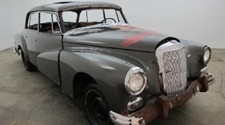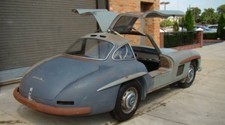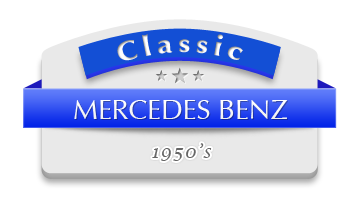Selling a Classic 1950’s Mercedes
Having largely recovered from World War II, German automaker Mercedes would launch onto the post-war automotive scene during the 1950’s with the popular Ponton series followed by the 300 line and the illustrious 300SL Gullwing. Today a symbol of iconic beauty and incredible styling, during the 1950’s the Mercedes 300SL would transition Mercedes Benz from being the purveyor of finely crafted sedans to being a leader in the advancement of 1950’s sports cars across the globe.
Always ahead of the curve when it comes to innovation, as well as automotive technology and safety, Mercedes Benz would roll out several advancements during the 1950’s. In 1951, for example, research would lead to a patent for the first safety car body with a rigid passenger cell and defined deformation zones. Often called “crumple zones,” this is a technology that is universally used today. Later, in 1958, development of every new Mercedes would include an increasingly rigorous regimen of crash testing. Initially performed outdoors, crash testing would become a vital learning tool in the automotive industry.
If you’re planning on selling a classic Mercedes from the 1950’s, below is a list of the most popular models and the characteristics of each that draw buyers.
Classic Mercedes 300, 300B, 300C, 300D:

Often referred to as the Type 300 “Adenauer” limousines, the Type 300 was a large, traditionally luxurious yet technologically advanced car that was placed at the top of an already exclusive Daimler-Benz lineup. Launched in 1951, the Type 300 was most often purchased by governments, heads of state, royalty and the affluent. The 300 was succeeded in 1954 by the 300B, which offered 10 more horsepower, larger brakes, higher compression and a pair of carburetors. In 1955, the 300C would launch with the first ever option for an automatic transmission. The line was almost cancelled, but thanks to demand, the 300D would release in 1956. The 300D was fuel injected and had a flatter, squared-off roofline, a slightly wider grille and a 4-inch longer wheelbase. It is undoubtedly the most attractive and sought-after of the line. In total, little more than 700 units in total were produced.
Classic Mercedes 300SL:

An icon of the automotive world, the Mercedes 300SL models would debut in 1954 and would cease production in 1962. On the track, the 300SL was a symbol of invincibility, while on the road it was extremely reliable, unbelievably attractive, and highly sought-after. Coupe models would see approximately 1,400 units, while approximately 1,858 models of the Roadster would take the road.
Classic Mercedes 190SL:

Known for its quality of design and workmanship, the classic Mercedes 190SL would see production from 1955 to 1963. Often called the “Little Brother” of the 300SL, the car was marketed to enthusiasts that could not afford the Gullwing and did not need the performance. If you’re looking to sell a 190SL, rust will be perhaps the main concern to buyers, as these are typically very bulletproof classics. In total, approximately 25,881 units of the 190SL were manufactured throughout the 1950’s and into the early 1960’s.
Classic Mercedes 220S, 220SE:

First launched as a Cabriolet in 1955 and later as a Coupe in 1956, the 220S and 220SE a hole in the market for a less expensive, more personal automobile when compared to the Mercedes 300 models of the era. If you’re selling a 220S or 220SE from the 1950’s, rust and originality will be two of the biggest concerns any educated buyer will have. Approximately 3,429 units of the 220S were produced from 1956 to 1959, as well as only 1,940 220SE models from 1958 to 1960.
For more information on the classic Mercedes of the 1950’s, please do not hesitate to connect with Alex Manos and his team of classic car professionals. Always looking to purchase classic of all makes, models and conditions, it would be their pleasure to learn more about your 1950’s Mercedes. Connect today to get started!
[sociable/]









